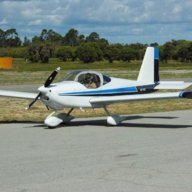-
Posts
2,249 -
Joined
-
Last visited
-
Days Won
19
Content Type
Profiles
Forums
Gallery
Downloads
Blogs
Events
Store
Aircraft
Resources
Tutorials
Articles
Classifieds
Movies
Books
Community Map
Quizzes
Videos Directory
Posts posted by rgmwa
-
-
1 hour ago, sfGnome said:
What load can you take with full fuel and 2 POB? The Tecnam was limited to about 20kg, which is fine for overnighters, but a bit of a problem for a week-long trip.
My 12 can take 50lb in the baggage compartment. The current 12’s can take 75 lb as the fuel tank has been relocated. My long trips have been solo so the passenger seat has been available for whatever I wanted to take.
-
A Sling 2 is good for 700 kg and would be a nice choice for either weight limit. I've never yet been loaded even to 600kg in the RV-12 on any trip.
-
Just watched the video of the ditching. Great example of how to do it well. Calm ocean and bystanders nearby also helped.
-
 1
1
-
 5
5
-
-
17 minutes ago, kgwilson said:
The price of a new 916is is $US49,500.00,
That should keep Lycoming in business for a while longer. Vans will sell you a 160hp Lycoming for US$35-$38k.
-
 1
1
-
 1
1
-
 1
1
-
-
1 hour ago, Kyle Communications said:
No its not...he tested it to how he wanted to...NOT to how the props are designed to be run
His testing was done as if you have a IFA or constant speed. These props are ground ajustable and designed to run a max rpm on a gearbox driven engine
If you set them up as per factory instructions you will get a substantial improvement in performance...more than 50 customers I have sent props to with maybe 15 or more different style of aircraft cant all be idiots..they know what performs better than what they had. I have not had one customer that did not get substantial performance increase
Are you a distributor for e-Props?
-
52 minutes ago, meglin said:
What is the maximum performance achieved in operation?
This link might be useful:
-
Yes, but lots of light planes have done similar trips going back to the biplane days without any anti or de-icing equipment.
It's just another risk that has to be managed as best you can if you are game enough to tackle something like that.
-
 1
1
-
-
Those Slings are very capable aircraft. They've done quite a number of similar long distance flights now.
-
Paint or powder coating under washers can result in torqued bolts losing tension over time which you can't check easily if Loctite has been used on the nuts or bolt threads. For example on engine mounting bolts.
-
 1
1
-
 2
2
-
-
No visible hatch to enable the chute to be deployed, and those external shroud attachment points would not work with a chute stowed inside the plane. Looks like an April Fools joke to me.
-
 1
1
-
-
My prop bolts are secured with Nordlocks.
-
 1
1
-
 1
1
-
-
Beautiful work! I would not pay the extra for carbon fibre. I don’t see much value in using it for wheel pants.
-
 1
1
-
 2
2
-
-
The real tragedy is the pilot's decision to try to make runway 23 by making a 220 degree turn at low altitude rather than land straight ahead in the paddock in front of him. The paddock is not that smooth but there are few good forced landing options around Serpentine and he was lined up to make use of about the best one available in terms of wind direction on the day and available space. Easy to be wise of course when you're not the one flying the plane and having to make the decision.
-
 2
2
-
 1
1
-
-
On the RV-12 which cruises at 110-115 knots they add about 4-5 kts to the top speed. On the faster RV’s that cruise at 150-170 kts I believe they account for about 9-10 kts.
-
The Aeroelectric Connection by Bob Nuckolls is another well regarded reference for homebuilt aircraft.
-
I considered writing but I live in Perth so the likelihood of me ever using the airfield is practically nil making anything I might say pretty unconvincing and probably unhelpful. Others may be in a similar situation.
-
Vans supply fibreglass wheelpants. They are optional kit items but nearly every RV has them. Pilots sometimes don't install them if they are flying off grass or rough surfaces but you won't find many RV's that don't have them.
-
 1
1
-
 1
1
-
-
He's got an interesting biography as a pilot and builder with over 27,000 hours in his logbook plus various records. https://en.wikipedia.org/wiki/Wayne_Handley
-
 2
2
-
-
This one has been around for a while but always worth another look.
-
 1
1
-
 1
1
-
-
I hope so. I bought 4 tickets so I expect perfection when I pick it up.
-
 1
1
-
-
7 hours ago, j578 said:
well????
Most of the users on this site are in Australia and New Zealand and although there are also many international participants such as yourself, not many here would be able to answer the specific question you asked.
-
 1
1
-
-
34 minutes ago, red750 said:
The Pentagon's R&D wing is taking the next steps towards developing airplanes that don't use traditional control surfaces like ailerons.
Current prototype (artist's impression):

-
 2
2
-
-
No, there's a Mark 2 Version.
-
 2
2
-
 1
1
-
-
From the Vans Airforce site:
-
 1
1
-
 3
3
-




How big is big enough?
in Aircraft Building and Design Discussion
Posted
Ah yes, but it’s not an RV 🙂